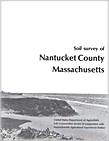The following map unit description is from the published "Soil Survey of Nantucket County, Massachusetts"

Soil Survey of
Nantucket County Massachusetts
The following map unit description is from the published "Soil
Survey of Nantucket County, Massachusetts"

ME-Medisaprists. These nearly level, very poorly drained soils are in depressional areas and potholes and in areas adjacent to open bodies of freshwater (fig. 8). Some areas have water ponded on the surface during most of the year. Areas are roughly circular or irregularly shaped and range from 2 to 100 acres.
The material in areas of Medisaprists is variable. Most areas have 16 inches to more than 60 inches of organic material that is commonly black muck. The organic material generally is highly decomposed.
Included with these soils in mapping are areas where the organic material has a very high fiber content and areas of Berryland Variant soils on slight rises. Inclusions make up about 15 percent of the unit.
The permeability of these soils is moderate or moderately rapid. Available water capacity is high. A seasonal high water table at a depth of less than 1 foot in fall, winter, and spring restricts root growth.
Most areas of these soils are covered with trees and shrubs. A few areas are covered with shrubs and grass. The soils are well suited to cranberries and wetland wildlife habitat but are poorly suited to most nonfarm uses.
When drained, these soils are suitable for crops. The seasonal high water table makes the soils poorly suited to hay and pasture and is the main limitation for farming. Surface drainage or open ditches or both help to remove water from the soil, but the soils subside when drained.
Medisaprists are limited for use as sites for buildings or for roads and streets by the seasonal high water table and the low strength of the organic material. Septic tank absorption fields in these soils generally do not function properly because of the seasonal high water table. Capability subclass not assigned.
MS-Medisaprists, sandy surface. These nearly level, very poorly drained soils are in depressional areas and potholes. Areas are roughly circular or oblong and range from 2 to 60 acres.
The material in these soils is variable. Many areas have 3 to 12 inches of gray sand on the surface that has been added to provide a rooting medium for cranberries. Beneath the sandy surface most areas have 16 inches to more than 60 inches of organic material that is typically black muck. The organic material generally is highly decomposed.
Included with these soils in mapping are areas where the organic material has a very high fiber content and areas of Medisaprists. These inclusions make up about 20 percent of the unit. Also included are small areas of Berryland Variant soils on slight rises. These make up about 10 percent of the unit.
The permeability of these soils is rapid in the sandy surface and moderate or moderately rapid in the organic material. Available water capacity is high. In some areas the seasonal high water table is at a depth of less than 1 foot in fall, winter, and spring, and it restricts root growth.
Most areas of these soils are used for cranberries, and the soils are well suited to that use. A few areas are covered with shrubs. The soils are suitable for wetiand wildlife habitat but are poorly suited to most other nonfarm uses.
When drained, these soils are suited to crops and hay (fig. 9). The soils are poorly suited to pasture. Wetness is the main farming management concern, although most areas have been drained. Surface drainage or open ditches or both help remove water from the soils, but the soils subside when drained.
The seasonal high water table and the low strength of the organic material limit the use of these soils as sites for buildings or roads and streets. The seasonal high water table makes the use of the soils for septic tank absorption fields unfeasible. Capability subclass not assigned.
More information on
Medisaprists (Freetown Soils)
More information on Cranberry Bed Soils (MS unit)